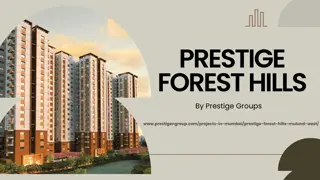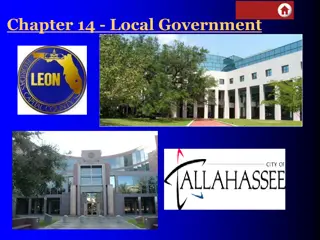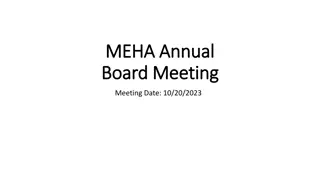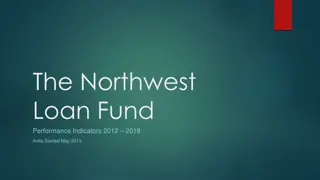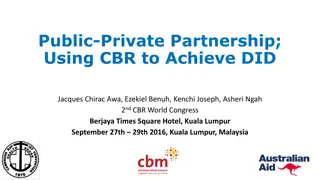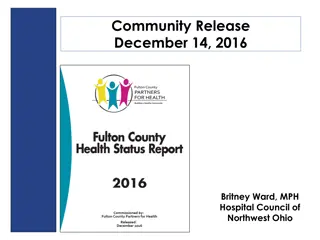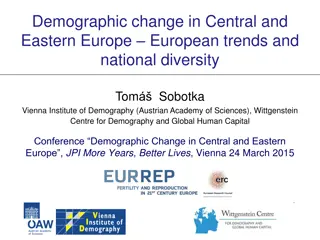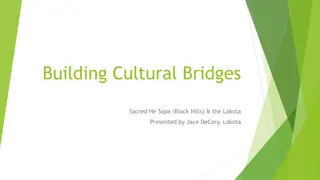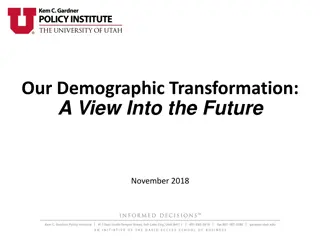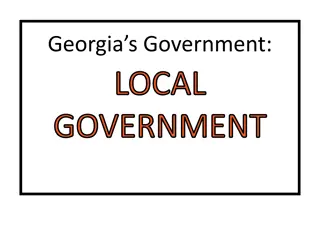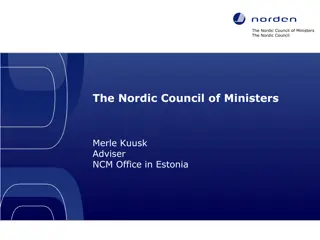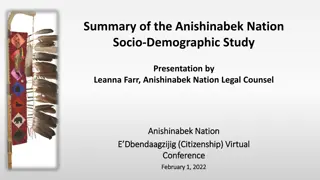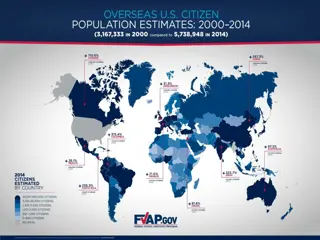Demographic Trends in Northwest Hills Council of Governments Region
The demographic data prepared for the Northwest Hills Council of Governments shows the historical population growth in the region from 1960 to 2010, comparing it to the state and national trends. The data highlights a 44% increase in the region's population, with specific towns experiencing significant growth or decline over different periods. The report also includes information on changes in total population, annual population changes, and projections for future growth up to 2025.
Download Presentation

Please find below an Image/Link to download the presentation.
The content on the website is provided AS IS for your information and personal use only. It may not be sold, licensed, or shared on other websites without obtaining consent from the author.If you encounter any issues during the download, it is possible that the publisher has removed the file from their server.
You are allowed to download the files provided on this website for personal or commercial use, subject to the condition that they are used lawfully. All files are the property of their respective owners.
The content on the website is provided AS IS for your information and personal use only. It may not be sold, licensed, or shared on other websites without obtaining consent from the author.
E N D
Presentation Transcript
Demographic Data Prepared for the Northwest Hills Council of Governments By the Connecticut Economic Resource Center 2016 *FINAL* 1
Total Population Total Population Historical Historical Population in the NHCOG region increased by 44% from 1960-2010 The region s long-term growth is slightly greater than that in the state (41%) but slower than that of the United States (72%) during the same 50 years The region had a population increase of 5% in the most recent ten- year period (2000-2010) Seven NHCOG towns saw their population more than double from 1960-2010: Burlington, 233%; Barkhamsted, 177%; Roxbury, 148%; Warren, 144%; Goshen, 131%; New Hartford, 130%; Morris, 101% Warren had the largest growth in the past 10 years (17%) Burlington, Canaan, Goshen, New Hartford, and Warren had double-digit growth in past 10 years Norfolk was the only town that had a decrease (-6%) over the 50-year period Five towns had a decrease over the last 10 years: Sharon, -6%; Salisbury, -6%; North Canaan, -1%; Cornwall, -1%; Washington, -1% 2
Change in Total Population Change in Total Population Historical U.S., Connecticut, and Region U.S., Connecticut, and Region Historical 20.0% 18.0% 16.0% Percent change from previous decade 14.0% 12.0% 10.0% 8.0% 6.0% 4.0% 2.0% 0.0% 1960-1970 1970-1980 1980-1990 1990-2000 2000-2010 United States Connecticut Northwest Hills 3 Source: U.S. Census; CT.gov
Total Population Total Population Historical By Town By Town Historical 40,000 35,000 30,000 25,000 20,000 15,000 10,000 5,000 0 1960 1970 1980 1990 2000 2010 Barkhamsted Burlington Canaan Colebrook Cornwall Goshen Hartland Harwinton Kent Litchfield Morris New Hartford Norfolk North Canaan Roxbury Salisbury Sharon Torrington Warren Washington Winchester 4 Source: U.S. Census; CT.gov
Annual Population Change Annual Population Change 140 120 100 80 60 40 20 0 -20 -40 Long-term (1960-2010) Recent (2000-2014) Projected (2015-2025) Sources: U.S. Census; CT.gov; CT Data
Annual Population Change Annual Population Change 3.0% 2.5% 2.0% 1.5% 1.0% 0.5% 0.0% -0.5% -1.0% -1.5% Long-term (1960-2010) Recent (2000-2014) Projected (2015-2025) Sources: U.S. Census; CT.gov; CT Data
Total Population Total Population Region s population increased 2% from 2001-2014 This is compared to a 5% increase in Connecticut and 13% increase in U.S. The region s overall population change ranged from an increase of 1% to a decrease of 1% each year during the period 12 towns increased their populations over this time period, and 9 towns had a population decrease In 2014, every town except Burlington saw a decrease in population Greatest decrease was in Canaan (-1.6%), which also had the biggest one-year increase in population during this period (12.6% increase in 2009-2010) Sharon had the biggest one-year decrease (-8.4% in 2009-2010) 7
Change in Total Population Change in Total Population U.S., Connecticut, and Region U.S., Connecticut, and Region 2.0% 1.5% Percent change from previous year) 1.0% 0.5% 0.0% -0.5% -1.0% -1.5% United States Connecticut Northwest Hills 8 Source: U.S. Census; CT.gov
Total Population Total Population By Town By Town 40,000 35,000 30,000 25,000 20,000 15,000 10,000 5,000 0 2000 2001 2002 2003 2004 2005 2006 2007 2008 2009 2010 2011 2012 2013 2014 Barkhamsted Burlington Canaan Colebrook Cornwall Goshen Hartland Harwinton Kent Litchfield Morris New Hartford Norfolk North Canaan Roxbury Salisbury Sharon Torrington Warren Washington Winchester 9 Source: CT.gov
Part Part- -time Population time Population Over 10% of the housing units in the NHCOG were classified as vacant for seasonal, recreational, or occasional use in 2014 The vacancy rate for seasonal or recreational properties was only 2% in the state and 4% in the nation Salisbury and Cornwall had the highest rates of seasonal vacant housing. In both towns, it was more than 30% of total housing units Salisbury also had the greatest absolute number of part-time use properties Assuming these vacant properties were occupied at the region s average household size, the region s seasonal population would represent almost 13% of the region s actual population Cornwall and Salisbury would have seasonal populations over 50% of their actual population, and an additional 7 towns would have seasonal populations that were at least 25% of the towns actual populations 10
Seasonal Vacancies (2014) Seasonal Vacancies (2014) 100% 90% 80% 70% 60% 50% 40% 30% 20% 10% 0% Vacant Units for seasonal, recreational, or occasional use Other units 11 Source: American Community Survey
Part Part- -time Population (2014) time Population (2014) 60.0% 50.0% Percent of actual population 40.0% 30.0% 20.0% 10.0% 0.0% 12 Source: American Community Survey
Population by Age Group Population by Age Group The population in the region is slightly older than that of the state and the nation: 18% of the population is over 65 years old in the region, while this cohort represents 15% of Connecticut s population and 14% of the U.S. population The region s population has historically been slightly older than that of the nation and the state The difference is even more dramatic adding in the cohort aged 45-64: those over 45 represent more than 50% of the region s population but only 43% of the state s and 40% of the nation s population Those under 18 years old comprise 20% of the region s population, 22% of the state s, and 24% of the nation s Of the towns, the over 65 population percentage is the greatest in Sharon (31%), Washington (25%), and Salisbury (25%) The relative percentage of the town s population over age 65 is smaller than the regional average in eight towns (Barkhamsted, Burlington, Colebrook, Goshen, Hartland, Morris, New Hartford, and Torrington) The relative percentage of the youth population (those under 18 years old) is greatest in Burlington (27%) and smallest in Sharon (13%) 13
Population by Age Group (2014) Population by Age Group (2014) U.S., Connecticut, and Region U.S., Connecticut, and Region 100% 90% 80% 70% 60% 50% 40% 30% 20% 10% 0% United States Connecticut Northwest Hills Under 18 18-44 45-64 Over 64 14 Source: U.S. Census; CT.gov
Population by Age Group (2014) Population by Age Group (2014) By Town By Town 100% 90% 80% 70% 60% 50% 40% 30% 20% 10% 0% Under 18 18-44 45-64 Over 64 15 Source: American Community Survey
Population by Age Population by Age Historical U.S., Connecticut, and Region U.S., Connecticut, and Region Historical 100% 90% 80% 70% 60% 50% 40% 30% 20% 10% 0% Under 18 18-44 45-64 Over 64 16 Source: U.S. Census; CT.gov
Population Projections Population Projections The region s population is projected to increase by 909 people, or 1%, from 2015-2025 11 towns are expected to lose population, ranging from an 11% decrease in Sharon to a 0.3% decrease in North Canaan New Hartford and Warren are projected to see the largest increases, 6.6% and 6.2%, respectively Projected decreases will be larger and projected increases smaller in the long term (from 2020-2025 compared to 2015-2020) Residents over 65 will comprise 23.8% of the region s population in 2020 and 28.0% in 2025 This age cohort will be 18.1% of the state s population in 2020 and 20.9% in 2025 The school-age population (those 19 years old or younger) will be 19.5% of the region s population in 2020 and 17.5% in 2025, compared to 23.0% and 22.0% of the state s population in 2020 and 2025, respectively 17
Population Projections Population Projections By Town By Town 40,000 35,000 30,000 25,000 20,000 15,000 10,000 5,000 - 2015 2020 2025 18 Source: CT Data Collaborative; Connecticut State Data Center
Public School Enrollment Public School Enrollment The region has seen an overall decrease in public school enrollment in town and regional school districts from 2001-02 academic year to 2014-15 All traditional town school districts and four of five regional schools (which provide elementary and secondary schools) had a decrease Largest decrease was over 51% in the Cornwall School District Only Regional School District 07 had an increase, which was less than 1% Charter schools had an increase in enrollment of 10% Capitol Region Education Council (CREC), which offers magnet school programs, and Education Connection, which offers educational programs in schools, saw increases in enrollment, although this included students from outside the NHCOG region (see slide 21) 19
Public School Enrollment Public School Enrollment Town School Districts Town School Districts 5,000 4,000 3,000 2,000 1,000 - Barkhamsted School District Canaan School District Colebrook School District Cornwall School District Hartland School District Kent School District Litchfield School District New Hartford School District Norfolk School District North Canaan School District Salisbury School District Sharon School District Torrington School District Winchester School District 20 Source: CT Data Collaborative; CT State Department of Education
Public School Enrollment Public School Enrollment Regional School Districts Regional School Districts 3,000 2,500 2,000 1,500 1,000 500 - Regional School District 01 Regional School District 06 Regional School District 07 Regional School District 10 Regional School District 12 21 Source: CT Data Collaborative; CT State Department of Education
Public School Enrollment Public School Enrollment Other Schools Other Schools 9,000 8,000 7,000 6,000 5,000 4,000 3,000 2,000 1,000 - Gilbert School District Explorations District CREC Education Connection 22 Source: CT Data Collaborative; CT State Department of Education
About CREC About CREC Member Communities NHCOG: Burlington, Hartland, Harwinton, New Hartford Other: Avon, Berlin, Bloomfield, Bolton, Bristol, Canton, Cromwell, East Granby, East Hartford, East Windsor, Ellington, Enfield, Farmington, Glastonbury, Granby, Hartford, Manchester, New Britain, Newington, Plainville, Portland, Rocky Hill, Simsbury, Somers, Southington, South Windsor, Suffield, Vernon, West Hartford, Wethersfield, Windsor, Windsor Locks Preschools and Elementary Schools Academy of Aerospace & Engineering Elementary School (PreK-5) Rocky Hill Discovery Academy (PreK - 5) Wethersfield Glastonbury-East Hartford Elementary Magnet School (PreK-5) Glastonbury International Magnet School for Global Citizenship (PreK-5) South Windsor Medical Professions and Teacher Preparation Academy (PreK) New Britain Montessori Magnet School (PreK-6) Hartford Museum Academy (PreK-5) Bloomfield and Windsor Reggio Magnet School of the Arts (PreK-5) Avon The CREC Ana Grace Academy of the Arts Elementary Magnet School (PreK-5) Avon University of Hartford Magnet School (PreK-5) West Hartford Secondary Schools Academy of Aerospace & Engineering (6-12) Windsor Greater Hartford Academy of Mathematics & Science: Half-Day Program (10-12 in School Year 2016-17) Windsor Greater Hartford Academy of the Arts (9-12) Hartford Greater Hartford Academy of the Arts Magnet Middle School (6-8) Hartford Medical Professions and Teacher Preparation Academy (6-12) New Britain Metropolitan Learning Center (6-12) Bloomfield Public Safety Academy (7-12 in School Year 2016-17) Enfield Two Rivers Magnet High School (9-12) Hartford Two Rivers Magnet Middle School (6-8) East Hartford 23
Educational Attainment Educational Attainment The population in the NHCOG area is relatively well- educated Only 9% of the population has less than a high school education, while 11% of the state population and 14% of the U.S. population does not have a high school degree (or equivalent) 14% of the regional population has a graduate degree, while 16% of the Connecticut population and 11% of the U.S. population hold graduate degrees Cornwall has the greatest proportion of graduate degree holders, relative to the town s population, at 32% Five towns have a smaller proportion of graduate degree holders than the region s 14% North Canaan has the largest percentage of the population that did not complete high school (15%) Torrington (14%) and Winchester (12%) also have a greater share of those without high school degrees than the region as a whole 24
Educational Attainment (2014) Educational Attainment (2014) By U.S., Connecticut, Region, and Town By U.S., Connecticut, Region, and Town 100% 90% 80% 70% 60% 50% 40% 30% 20% 10% 0% Less than high school graduate High school graduate (includes equivalency) Some college or associate's degree Bachelor's degree Graduate or professional degree 25 Source: American Community Survey
Household Income Household Income Median household income is higher in the region than in both the state and the nation Torrington has the lowest median household income, and Burlington has the highest No town has a lower median household income than that in the United States as a whole Five towns have a median household income lower than that in the state Income distribution in the region tends to skew toward higher income groups 13 towns have a larger share of households earning $200,000 or more than in the region as a whole From a historical perspective, the region has generally had smaller shares of the lowest and highest income families compared to the state 26
Household Income (2014) Household Income (2014) U.S., Connecticut, and Region U.S., Connecticut, and Region 100% 90% 80% 70% 60% 50% 40% 30% 20% 10% 0% United States Connecticut Northwest Hills <$10K $10K-$25K $25K-$50K $50K-$75K $75K-$100K $100K-$150K $150K-$200K >$200K 27 Source: American Community Survey
Household Income Household Income Historical U.S., Connecticut, and Region U.S., Connecticut, and Region Historical 100% 90% 80% 70% 60% 50% 40% 30% 20% 10% 0% <$10K $10K-$25K $25K-$50K $50K-$75K $75K-$100K $100K-$150K $150K-$200K >$200K 28 Source: U.S. Census; CT.gov
Household Income (2014) Household Income (2014) By Town By Town 100% 90% 80% 70% 60% 50% 40% 30% 20% 10% 0% Less than $25K $25K-$35K $35K-$50K $50K-$100K $100K-$200K Over $200K 29
Households in Poverty Households in Poverty The region had both a smaller percentage of households below the poverty line and a smaller proportion of households receiving support from the Supplemental Nutrition Assistance Program (SNAP) than the state and the nation Only eight towns had a poverty rate above the regional rate, and only two of these towns had a poverty rate greater than that in Connecticut No town had a poverty rate greater than in the United States Barkhamsted had both the lowest poverty rate and the lowest absolute number of households in poverty, while Goshen had the highest poverty rate and Torrington had the highest number of households in poverty Three towns had a greater proportion of households receiving SNAP than in the region or the state (Canaan, Torrington, and Winchester) With the exception of Canaan, all towns had a higher percentage of households in poverty than those receiving SNAP 30
Households in Poverty (2014) Households in Poverty (2014) U.S., Connecticut, and Region U.S., Connecticut, and Region 18.0% 16.0% Percent of households in poverty 14.0% 12.0% Percent of households receiving SNAP 10.0% 8.0% 6.0% 4.0% 2.0% 0.0% United States Connecticut Northwest Hills 31 Source: American Community Survey; CT Data Collaborative
Households in Poverty (2014) Households in Poverty (2014) By Town By Town 16.0% 14.0% 12.0% 10.0% 8.0% 6.0% 4.0% 2.0% 0.0% Percent of households in poverty Percent of households receiving SNAP 32 Source: American Community Survey; CT Data Collaborative
About the American Community About the American Community Survey Survey The American Community Survey (ACS) is an ongoing survey conducted by the U.S. Census Bureau that provides annual estimates of the national population with respect to a variety of indicators. It is used by decision makers at all levels of government and in private businesses and nonprofit organizations to assess the characteristics including changes of the U.S. population. It is a part of the decennial census conducted by the U.S. Census Bureau to understand population characteristics during the interim periods. It has a sample design, with the findings weighted to measure the characteristics of the population within specific margins of error or confidence intervals. ACS results are provided in one-, three- and five-year estimates. Use of the five-year estimates provides a larger sample size and, thus, more precision. This is especially useful for smaller geographic areas, as in the case of most of the towns in the NHCOG region. As such, the results provided in this analysis are from the 2010-2014 ACS, which are the most recent five-year estimates available. The Census Bureau also regularly revisits its weighting and sampling methodology, to ensure reliable estimates. For the five-year ACS used here, the Census conducted interviews with over 113,000 randomly selected households in the state. 33




